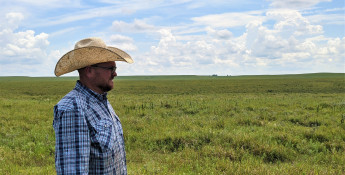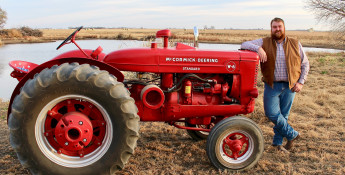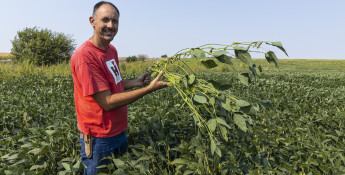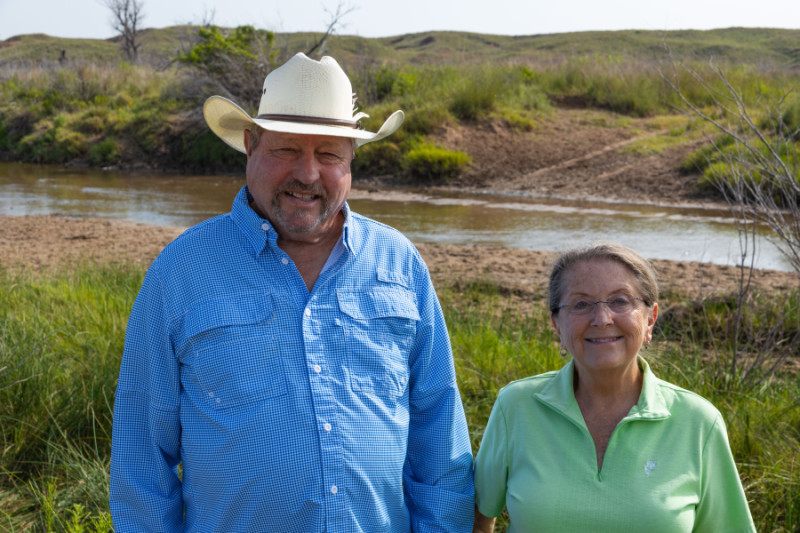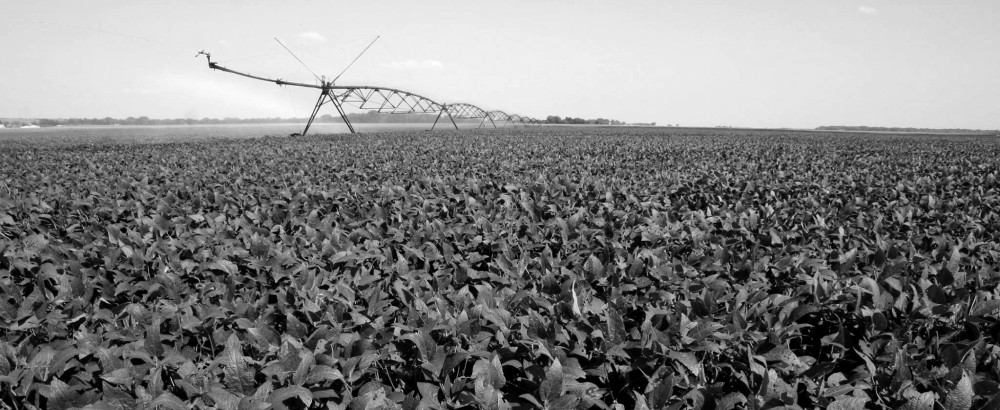By Sheridan Wimmer on May 8, 2025
Barbys Recognized with 2024 Kansas Leopold Award
Fire management, water conservation and ecosystem development earn Bill and Debbie Barby the 2024 Kansas Leopold Conservation Award
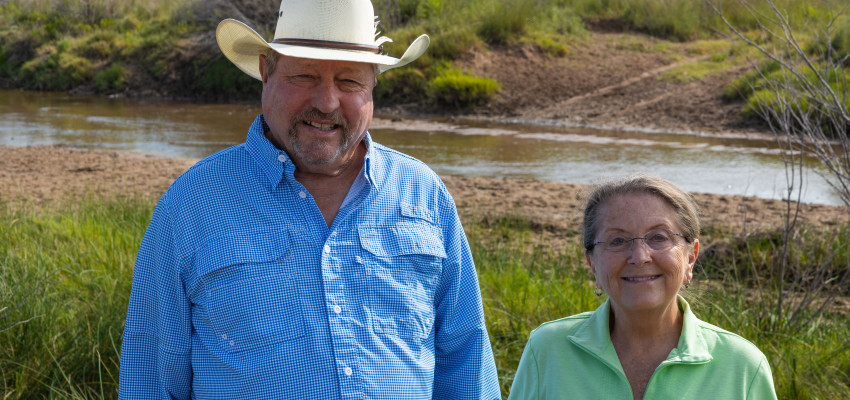
Farmers and ranchers are widely considered the original conservationists. From hunting and gathering to the cultivation of plants, agriculturists have evolved their knowledge of caring for our soil, water and air on this blue marble we call Earth.
Ancient civilizations developed practices that paved the way for current farmers and ranchers to learn from their early mistakes. To advance in anything, you must start with something. Farmers and ranchers have learned from the generations before them so they can better care for our natural resources.
One visionary conservationist in American history, Aldo Leopold, held a deep dedication to “land ethic,” as he called it. The term refers to a devotion to an ethical, caring relationship between people and nature. Leopold wrote “A Sand County Almanac,” a collection of essays on his innate love of all wild things and was accepted for publication by Oxford University Press in 1948, just one week before his passing.
His legacy and love for conservation and nature formed the land ethic he hoped private landowners would subscribe to and ultimately improve land, water and wildlife. Sand County Foundation, a national nonprofit organization formed nearly 60 years ago, takes the ethos of Leopold and applies it in practical ways, including through its Leopold Conservation Award Program, which recognizes and celebrates achievement in voluntary conservation by agricultural landowners.
Championing stewardship and sustainability
Ninety-eight percent of Kansas’ land is privately owned, and more than 44 million acres in Kansas is agricultural land. The farmers and ranchers of Kansas are dedicated to improving soil health, enhancing wildlife habitats, developing water quality and quantity measures and providing clean air we all breathe.
Protection is not just the town closest to Bill and Debbie Barby’s ranch in rural Clark and Comanche counties, it’s also the way they see their conservation efforts. Because of their dedication to conservation, the Barby Ranch was selected as the 2024 Kansas Leopold Conservation Award winner, an honor that highlights the work of the Barbys and comes with a $10,000 reward.
“These award recipients are examples of how Aldo Leopold’s land ethic is alive and well today,” Kevin McAleese, Sand County Foundation president and CEO, says. “Their dedication to conservation is both an inspiration to their peers as well as a reminder to all how important thoughtful agriculture is to clean water, healthy soil and wildlife habitat.”
Healthy soil is the cornerstone of the Barby Ranch, and clean water, thriving grasslands and abundant wildlife are essential to its sustainability.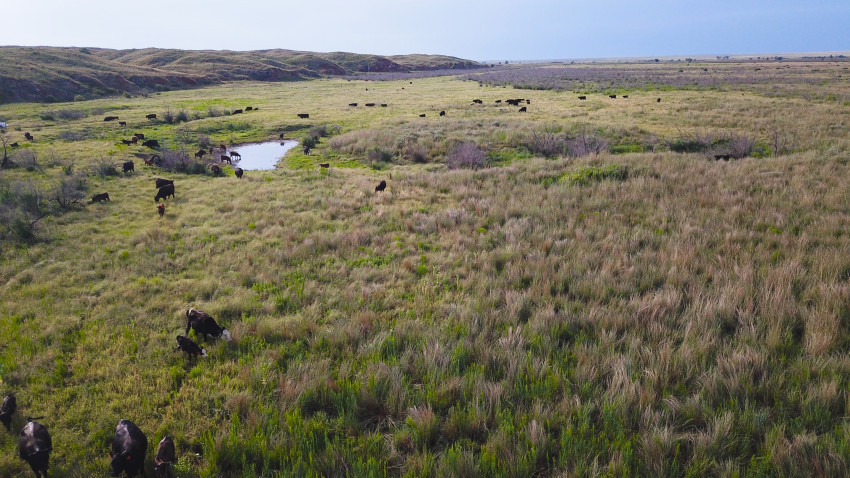 “Our operation is all a native grass ranch, and the Cimarron River runs down the middle of it,” Bill says. “We are committed to growing strong, healthy grass and soils so when we graze our cattle, we are sure to let it rest and have full recovery before being grazed again.”
“Our operation is all a native grass ranch, and the Cimarron River runs down the middle of it,” Bill says. “We are committed to growing strong, healthy grass and soils so when we graze our cattle, we are sure to let it rest and have full recovery before being grazed again.”
The ranch is extremely remote, which poses some challenges but ultimately, it’s how the Barbys can concentrate on land management and see the positive results of being so mindful.
"We're totally off the grid,” Bill says. “We're five miles from the closest road we can access for our property, so it’s very remote.”
The Barby Ranch may be remote, but they are close at heart with conservation efforts. Rotational grazing, prescribed burns and removing invasive species of trees are just a handful of the ways Bill and Debbie have restored native habitats and naturally occurring ecological systems.
Fighting fire with fire
Prescribed burns, also called controlled burns, have been a conservation practice used in Kansas for thousands of years. Native Americans used fire, which they called “the red buffalo,” to attract bison to the fresh green grass that came after the burns. Today’s conservationists use controlled burns to stave off the risk of wildfires, and especially in Kansas where wind speeds can be both erratic and high, preventing wildfires is an important measure to protect livestock, eliminate invasive species like Eastern Red Cedars and Saltcedar and encourage new grass growth.
In 2017, the Starbuck wildfire burned more than 450,000 acres in Clark, Comanche and Meade counties, including the Barby ranch.
“We do prescribed burns, and we had several hundred acres already prepared to burn and were just waiting for the right day for the weather to cooperate,” Bill says. “If we would have had that accomplished ahead of time, that would have been a huge safety net for me to move my cattle onto that burned area so they would have been safe in the Starbuck wildfire.”
Bill moved some of his yearling cattle about a mile away to the middle of a neighbor’s no till wheat field, which was green. While Bill was leaving the field after his cattle were as safe as they could be, he noticed his neighbor’s cows over a bluff, and he knew they would have died in the wildfire.
“I moved them to the field too, but I was worried about getting out of there myself,” Bill says. “There was only one way out, and I fortunately made it. Then I had to go to the river to find my main cow herd, and I couldn’t find them. But by the grace of God, those cows survived even with singe marks on them and burned hair. I’ll never know what happened, but I was so fortunate.”
The Barbys were lucky, but others lost their livestock, homes, buildings, fence and more in the Starbuck fire.
“It was a pretty ugly site when the sandhills were all burned up and fences were laying on the ground,” Bill says. “But as soon as we got some rainfall, our grasses recovered quickly. And that’s mostly because we rest our grasses and keep them healthy.”
Weathering drought and managing water
Water is always an important aspect for Kansas agriculture. Whether it’s the quality of the water or the quantity, farmers and ranchers have water on the forefront of conversations in conservation. While the southeastern portion of Kansas typically receives more than 45 inches of rain annually, the western side of the state will receive less than 18 inches of rain a year.
Drought is always a concern for farmers and ranchers, and the Barby’s western Kansas ranch is no outlier. Bill has his eye to the future when it comes to the wellbeing of his land – with water top of mind.
“One of our goals in our grazing management plan is we want to drought-proof our ranch,” Bill says. “The way we do that is by keeping our grass really healthy. In 2011, we didn’t receive any usable rainfall. In those cases, we have to look at our management plan that has trigger dates, which tell us what our plan of action is if we don’t have a certain amount of rainfall by those specific dates. We’ll have droughts in the future, but with our drought and management initiatives, we’re able to plan better.”
In the event rainfall hasn’t equaled what it should according to his drought plan, Bill will either send some of his herd to another state with more grass available or cull some of the herd.
“We learn as we go,” Bill says.
Solar energy is another important aspect of the Barby Ranch’s water conservation success. Because they are so remote, depending on the sun’s energy allows them to use solar power to pump water to storage tanks.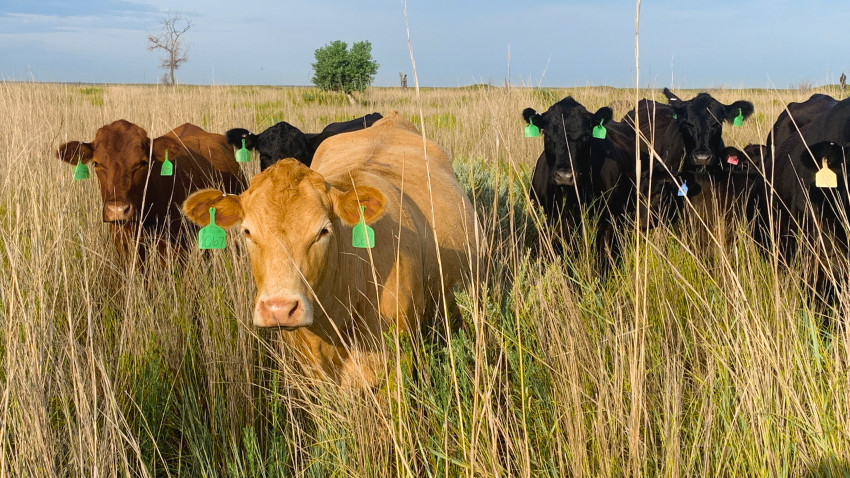 “We started putting in solar 20 years ago,” Bill says. “We pump water uphill to storage tanks and through a series of pipelines, it would gravity flow down to a series of tanks in different paddocks. Solar has been really good for us, and because we group our cattle together in one herd for grazing efficiency, we needed a water system that was capable of large herd capacities.”
“We started putting in solar 20 years ago,” Bill says. “We pump water uphill to storage tanks and through a series of pipelines, it would gravity flow down to a series of tanks in different paddocks. Solar has been really good for us, and because we group our cattle together in one herd for grazing efficiency, we needed a water system that was capable of large herd capacities.”
Supporting biodiversity through rest
Bill’s dedication to grasslands, soil and water resources trickle into an abundant and thriving wildlife ecosystem on his land.
“Giving our land 90 percent rest by grazing in one paddock while the rest of the ranch is resting is beneficial to the biodiversity of the land and wildlife,” Bill says. “Our resting method has increased the biodiversity on our land exponentially. We have had Fort Hays State University come out for a study and they identified more than 200 different plants and forbs. We’ve also had the Bird Conservancy of the Rockies come out and do bird surveys. They’d identify bird sounds, and I asked to see the results to see how I compared to other areas and we always led the bird population. That was a sign of having healthy grasslands and soils. There have also been numerous fish and stream surveys, which had a long list of species they had found. It’s fun letting groups come in and do that because it benefits them, but I also get a lot of information I wouldn’t have otherwise.”
A lifelong commitment of stewardship
While the honor of being named the 2024 Kansas Leopold Conservation Award winner means a lot to Bill, his dedication to the land and community is where he feels the highest reward.
“To me, being a land steward is the highest award you can receive,” Bill says. “We’re put here to be stewards of the earth and to receive an award like the Leopold award is very meaningful for me. We’re providing communities with clean water, clean air and high-quality beef.”
Bill Barby knew from an early age he wanted to be a rancher.
“Being a rancher is all I’ve ever done and all I’ve ever wanted to do. In first grade, our teacher asked what we wanted to be when we grew up and I knew right then that I wanted to be a rancher. It was amazing I had that calling at my life at such a young age and I recognized it.”
Many of us would have answered differently in first grade – but for Bill Barby, his calling in being a steward of the land was a dedication of respect, responsibility and a deep-rooted commitment to be a caretaker.
To learn more about the Leopold Conservation Award, which is offered in 28 states by the Sand County Foundation, visit https://sandcountyfoundation.org/. You can view a video about Barby Ranch at bit.ly/barbyranch_video.

